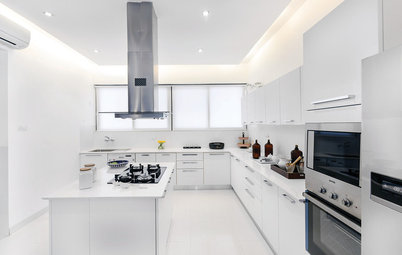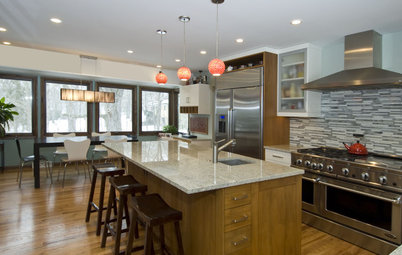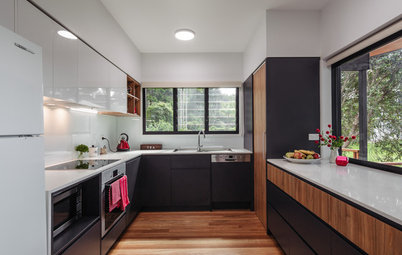Kitchen Guides
Which Laminate Is Best for Kitchen Cabinets?
Here are our tips and advice on how to select laminates that are best suited for your kitchen cabinetry
Deciding on the colour and finish of kitchen laminates can be an exciting and challenging job. After all, the cabinets will decide the look and feel of your kitchen.
Laminates are widely preferred for both modular and conventional (carpentered) kitchens – they are categorised as high-pressure laminates, used on plywood, and low-pressure laminates that are used on MDF or particle board. Laminates come in multiple options of colours and finishes that replicate leather, wood or stone, in thicknesses ranging between 0.6 millimetre to 1.5 millimetres. I recommend you go for high-pressure laminates in your kitchen because they come with qualities like durability, low maintenance, high resistance to heat and economic viability.
Here is a comprehensive guide on the kinds of laminates out there.
Laminates are widely preferred for both modular and conventional (carpentered) kitchens – they are categorised as high-pressure laminates, used on plywood, and low-pressure laminates that are used on MDF or particle board. Laminates come in multiple options of colours and finishes that replicate leather, wood or stone, in thicknesses ranging between 0.6 millimetre to 1.5 millimetres. I recommend you go for high-pressure laminates in your kitchen because they come with qualities like durability, low maintenance, high resistance to heat and economic viability.
Here is a comprehensive guide on the kinds of laminates out there.
2. Gloss finish laminate
A glossy laminate finish has an attractive mirror-like sheen. It imparts a luxurious look to the kitchen and adds brightness to the space because of its ability to reflect a bit of light.
Gloss-finish laminates are susceptible to scratches and need regular cleaning because they show smudges and fingerprints easily.
Pro tip:
Can’t decide between glossy and matte? In that case, consider a mix-and-match of these two cabinet finishes. One way could be to demarcate the upper cabinets with a gloss finish and the lower cabinets with a matte finish. The ceiling lights will be effective in highlighting the glossy surface of the upper cabinets while an easy-to-clean matte finish is perfect for the lower cabinets, which are regularly used and subjected to more wear and tear.
A glossy laminate finish has an attractive mirror-like sheen. It imparts a luxurious look to the kitchen and adds brightness to the space because of its ability to reflect a bit of light.
Gloss-finish laminates are susceptible to scratches and need regular cleaning because they show smudges and fingerprints easily.
Pro tip:
Can’t decide between glossy and matte? In that case, consider a mix-and-match of these two cabinet finishes. One way could be to demarcate the upper cabinets with a gloss finish and the lower cabinets with a matte finish. The ceiling lights will be effective in highlighting the glossy surface of the upper cabinets while an easy-to-clean matte finish is perfect for the lower cabinets, which are regularly used and subjected to more wear and tear.
3. Textured laminate
An easy way to subtly bring in a sense of depth into a monochromatic kitchen is with textured laminate. Textures that simulate the feel and appearance of elements like solid wood are most appropriate for kitchens.
Note that a heavily textured surface is more scratch-resistant but also more likely to trap dust and grime.
Tip: The routine cleaning of textured laminate should include a regular wipe with a damp cloth. For deeper cleaning a light solution of soapy water is sufficient; avoid abrasive cleaners or steel-wool scrubbers as they might damage the surface.
An easy way to subtly bring in a sense of depth into a monochromatic kitchen is with textured laminate. Textures that simulate the feel and appearance of elements like solid wood are most appropriate for kitchens.
Note that a heavily textured surface is more scratch-resistant but also more likely to trap dust and grime.
Tip: The routine cleaning of textured laminate should include a regular wipe with a damp cloth. For deeper cleaning a light solution of soapy water is sufficient; avoid abrasive cleaners or steel-wool scrubbers as they might damage the surface.
4. Solid colour laminate
You can introduce multi-coloured laminates to add vibrancy and a zing to the kitchen space. How? Combine two (or maybe three, as in this example) different colours on kitchen drawers and cabinets. Choose shades that play off each other effectively – perhaps a deeper shade, like the yellow here, for a bit of pep and the white to keep the space looking open and bright. The grey accents are ingenious: they add depth to the whole scheme.
Tip: Scratches are less visible on light colours than dark ones.
One drawback with most laminates is that once the laminate chips it is not possible to repair it. In case of damage the the whole laminate panel has to be replaced. Note that metal-finish laminates are stronger and do not chip easily.
You can introduce multi-coloured laminates to add vibrancy and a zing to the kitchen space. How? Combine two (or maybe three, as in this example) different colours on kitchen drawers and cabinets. Choose shades that play off each other effectively – perhaps a deeper shade, like the yellow here, for a bit of pep and the white to keep the space looking open and bright. The grey accents are ingenious: they add depth to the whole scheme.
Tip: Scratches are less visible on light colours than dark ones.
One drawback with most laminates is that once the laminate chips it is not possible to repair it. In case of damage the the whole laminate panel has to be replaced. Note that metal-finish laminates are stronger and do not chip easily.
5) Metal finish laminate
To bring in a sleek, modern look to your kitchen, consider a laminate with a metallic finish. There is a richness in the sheen of metal laminates that effortlessly imparts a high-end look to the kitchen. These are comparatively more expensive than other laminate finishes and are available in fewer colour options, like silver, copper and rose gold.
In this picture, brushed steel is used throughout the kitchen. You could consider pairing it with a non-reflective matte finish laminate for a smart contrast.
Tip: Keep in mind that the edges of metal laminates are very sharp, so ensure good workmanship at the time of installation.
Pro tip: Another innovation is the introduction of flame-resistant laminates. They inhibit the spread of flames and are highly suitable for kitchens. The laminate is treated with fire-resistant materials to minimise the smoke emissions that may be caused by fire and they also delay the build up of temperature. Brands like Greenlam and CenturyPly offer fire-retardant laminates.
Also consider laminates that are antibacterial (available with companies like Durian) – such a surface improves kitchen hygiene by checking the growth of germs and bacteria.
Read more:
What’s the Best Material for Kitchen Cabinets?
A Kitchen Designer’s Top 10 Cabinet Solutions
Tell us:
Which laminate would you consider for your kitchen? Tell us why in the Comments section below.
To bring in a sleek, modern look to your kitchen, consider a laminate with a metallic finish. There is a richness in the sheen of metal laminates that effortlessly imparts a high-end look to the kitchen. These are comparatively more expensive than other laminate finishes and are available in fewer colour options, like silver, copper and rose gold.
In this picture, brushed steel is used throughout the kitchen. You could consider pairing it with a non-reflective matte finish laminate for a smart contrast.
Tip: Keep in mind that the edges of metal laminates are very sharp, so ensure good workmanship at the time of installation.
Pro tip: Another innovation is the introduction of flame-resistant laminates. They inhibit the spread of flames and are highly suitable for kitchens. The laminate is treated with fire-resistant materials to minimise the smoke emissions that may be caused by fire and they also delay the build up of temperature. Brands like Greenlam and CenturyPly offer fire-retardant laminates.
Also consider laminates that are antibacterial (available with companies like Durian) – such a surface improves kitchen hygiene by checking the growth of germs and bacteria.
Read more:
What’s the Best Material for Kitchen Cabinets?
A Kitchen Designer’s Top 10 Cabinet Solutions
Tell us:
Which laminate would you consider for your kitchen? Tell us why in the Comments section below.


















This laminate has moderate reflectiveness and a consistent, standard finish. Matte-finish laminates bring a look of functionality and quiet elegance to a kitchen space.
The greatest advantage of these laminates is that they have excellent resistance to scratches and dust, which makes them easy to clean and relatively maintenance-free.
Opt for a 1-millimetre-thick laminate for the external surface of the cabinet and a 0.7-millimetre-thick laminate as liner for the insides of the cabinet and drawers – this will ensure a neat look and make cleaning easy.
Pro tip: As a precaution, you must take care to protect all laminated surfaces from sustained exposure to water or excessive moisture as it may loosen the laminate from its base, which might be difficult to fix.